- 1.1 Displays
- 1.2 Laying Track
- 1.3 Building Stations
- 1.4 Building Trains
- 1.5 Trains as Copy Protection
- 1.6 Economy
- 1.7 Industry and Cargo
- 6.1
Gameplay [ ]
The objective of Railroad Tycoon is to build and manage a railroad company by laying track, building stations, and buying and scheduling trains. The player acts a railway entrepreneur may start companies in any of four geographic locales: the Western United States, Northeast United States, Great Britain, or Continental Europe. The company starts with one million dollars in capital; half equity, half a loan. The company may raise additional capital through the sale of bonds. The player then builds stations and track between two cities, where a train can be sent between the two. There are many different types of cargoes that are supplied and demanded, and the player earns money by taking these cargo to different places through the management of trains. The game usually starts in the early 1800's where only steam locos are available that are slow and unreliable. Eventually as the game goes on, a larger variety of locomotives are offered, including diesel and electric trains that move efficiently across the network.
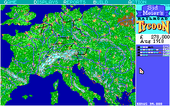
Displays [ ]
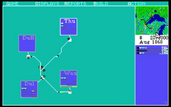
The original game has four main views in which the player can choose to view the game through. The most comprehensive view is the Regional View, where you can view your network from afar. This display gives you the complete picture of the world. It shows the basic geography, including the location of mountains and rivers, and also indicates centers of population. If railroads have started operating, they are visible as well.
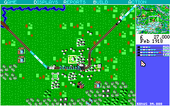
The Area Display is the next zoom down from the Regional Display and is a schematic display of any built railroad. It shows no geography, but only the track, signals, trains, stations, and Station Boxes (if not toggled off) of the player's Railroad.
The Local Display is the second zoom down from the Regional Display and shows not only your railroad’s features, but also the local geography and industry. From this display you can plan the expansion of your railroad into nearby areas with good population centers or industrial sites, while keeping the location of mountain and river obstacles in view.
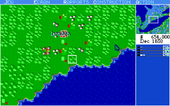
The Detailed Display is the closest zoom possible, and is the display at which all railroad construction is done. This display shows in greatest detail the geography, population centers, and industrial sites on the map. From this display only, the player may survey the local geography and plan in detail the laying of track.
Laying Track [ ]
In Railroad Tycoon, laying track is the only way to transport goods across to different destinations, and this is mostly done in the detailed view. A grid system is employed in RRT, the track can be built in 8 directions, and each track piece when built fits on one tile. 45 degree curves are allowed in RRT, as well as 90 degree turns, although they are not recommended as they significantly slow your trains down. It is also possible to have a track split off an existing track piece at a 45 degree angle (not a 90 degree angle), but the original track must be a straight section. Track may also be turned into double track (extra line), to allow for double the amount of trains to travel at once. However, it is expensive and is only recommended for busiest parts of the network.
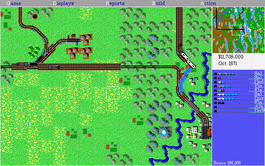
When building track, players are encourage to think about the amount of curves and grades that the track has, as it will slow the trains down and cause traffic jams. Even the smallest grades will slow down the trains when they go uphill, so it is important to find a way around large grades. It is possible to build tunnels in Railroad Tycoon, which despite expensive, allows tracks to cross mountains while providing a flat gradient. It is possible for trains to cross tidal estuaries, the ocean or large lakes with the help of ferryboats. A ferry route may include curves but may not be double tracked. Trains also move very slowly on Ferry Routes.
River bridges can also be built in Railroad Tycoon, but only in a straight line over one river square. The bridge is built from the starting square to the first land square on the river’s other side. Bridges allow trains to go across rivers, but they are prone to flooding, and a train stuck on a bridge during a flood is destroyed. There are 3 different types of bridges, each with their advantages and weaknesses.
- Wooden Trestle Bridge ($50,000) [cheap, prone to flooding, only single track, trains move 50% slower]
- Steel Girder Bridge ($200,000) [medium price, flood resistant, must wait till technology is available]
- Stone Masonry Bridge ($400,000) [expensive, can't be flooded, available from start]
Building Stations [ ]
In Railroad Tycoon stations are the only places that trains can stop to pick up and deliver cargoes. Building track into industrial sites or cities has no effect on creating supply and demand for cargoes. The transfer facilities that automatically come with a station must be present for pickups and deliveries to take place. There are three types of stations: Depots ($50,000), Stations ($100,000), and Terminals ($200,000). They are differentiated by their cost, economic radius, and map icon. All industrial and population sites within the radius of a station send (supply) and receive (demand) business through the station. By adding together the supply and demand for cargoes from the industry and population within range, the supply and demand for the station is determined. For example, assume each coal mine creates an average supply of two carloads of coal per year. A station with three coal mines within its economic radius then generates a supply of about six carloads of coal per year.
In Railroad Tycoon, stations can also have facilities that could help improve the efficiency of the station. At each station (but not signal towers) it is possible to build any of the following improvements:
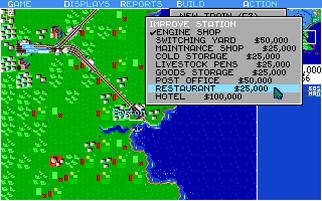
- Engine Shop ($100,000) [allows the building of locomotives, automatically built in first station]
- Switching Yard ($50,000) [locomotives can change cars 75% faster]
- Maintenance Shop ($25,000) [locomotive that passes through pays 75% less maintenance yearly]
- Cold Storage ($25,000) [Food cargo never wastes at the station]
- Livestock Pens ($25,000) [Livestock cargo never wastes at the station]
- Goods Storage ($25,000) [Goods cargo never wastes at the station]
- Post Office ($50,000) [Mail cargo never wastes at the station]
- Restaurant ($25,000) [Higher Revenue from Passengers]
- Hotel ($100,000) [Higher Revenue from Passengers]
Building Trains [ ]
The objective of the game is to make money by transporting cargoes across to destinations and this is done primarily by trains. When at least one engine shop exists on your road, you may build new trains from any Display. A window will pop-up displaying which locomotives are currently available (depends on the time period), and the player will need to choose one. Some trains are fast, while others are more suited to pulling heavy cargo or going on heavy grades. Here is the full list of trains available based on location:
| Europe | America |
|---|---|
| 2-2-0 Planet | 0-4-0 Grasshopper |
| 2-2-2 Pantentee | 4-2-0 Norris |
| 4-2-0 Iron Duke | 4-4-0 American |
| 0-6-0 Dx Goods | 2-6-0 Mogul |
| 4-2-2 Stirling 8ft Single | 4-6-0 Ten Wheeler |
| 0-8-0 Webb Compound | 2-8-0 Consolidation |
| 4-4-0 Claud Hamilton | 4-6-2 Pacific |
| 4-6-2 A1 Class | 2-8-2 Mikado |
| 4-6-2 A4 Class | 4-6-6-4 Challenger |
| 6/6 GE Class Crocodile | |
| 1-Do-1 Class E18 | EMD F Series Diesel-Electric |
| 4-8-4 242 A1 | |
| Bo-Bo-Bo RE Class 6/6 | |
| TGV |
The EMD GP series Diesel-Electric locomotive was listed in the game mannual as well as seen on the title screen, but had been omitted from the game due to space limitations.
Trains as Copy Protection [ ]
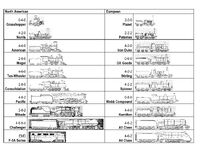
Like many games of its time, Railroad Tycoon "protected" itself from copying by challenged players to identify something from the manual at startup, namely identifying trains. As this game is now available both via download for play in emulators and via online classic game sites, a quick-access guide is provided. Note that the copy protection used only some of the available trains, so the guide does not include all the trains listed above.
Economy [ ]
The player acts as a railway entrepreneur who owns and manages the business as described above and may also handle individual train movement and build additional industries. The game models supply and demand of goods and passengers as well as a miniature stock market on which players can buy and sell stock of their own or competing companies. The game also has other railroad companies attempting to put the player out of business with stock dealings and "Rate Wars".
Industry and Cargo [ ]
Scenarios [ ]
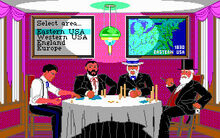
Each game gives the player 100 years to build their railroad as big as possible, and the time frame depends on the scenario.
- Eastern USA (1830-1930)
- Western USA (1866-1966)
- England (1828-1928)
- Europe (1900-2000)
Before starting the scenario however, the player gets to choose the level of difficulty ranging between, investor (easiest), financier, mogul and tycoon (hardest). There are also three further options that can change the reality level of the game, and these are:
| Reality Levels | Description |
| “No Collision Operation/ Dispatcher Operation” | If “Dispatcher Operation” is selected from the menu, that turns off the “No Collision” option and the game is set to play with more complex train |
operations. In this case, the movement of trains is controlled by block
signals, and collisions are possible. It is recommended that new players should choose No Collisions.
to take you over, or start rate wars at your stations. If the competition is cut-throat, they will aggressively buy your stock, try to take you over, and start rate wars to capture your stations, making the game much more challenging. New players should keep the competition friendly.
Each time the map is generated, industries always appear in different places, so each time the strategy used by the player will be different.
Development [ ]
Soundtrack [ ]
Sid Meier's Railroad Tycoon Deluxe [ ]
Sid Meier's Railroad Tycoon Deluxe was an enhanced version of the game released in 1993. This version plays much like the original, but has enhanced graphics, digital sound effects, as well as new maps, cargo types, and engines. The "England" map is replaced with an "Africa" map, and the "North America" and "South America" maps are added. The "Africa" map features the European engines, and "South America" features the engines from the US maps.
Sequels [ ]
External links [ ]
- Title at Moby Games
- Title at Gamefaqs